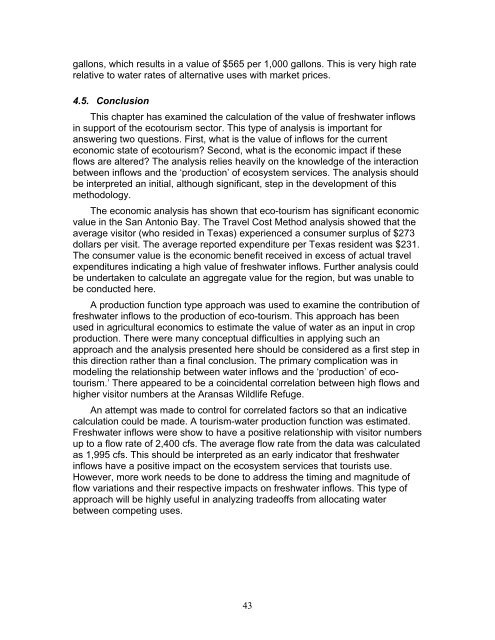The Economic Value of Water and Ecosystem Preservation
The Economic Value of Water and Ecosystem Preservation
The Economic Value of Water and Ecosystem Preservation
Create successful ePaper yourself
Turn your PDF publications into a flip-book with our unique Google optimized e-Paper software.
gallons, which results in a value <strong>of</strong> $565 per 1,000 gallons. This is very high rate<br />
relative to water rates <strong>of</strong> alternative uses with market prices.<br />
4.5. Conclusion<br />
This chapter has examined the calculation <strong>of</strong> the value <strong>of</strong> freshwater inflows<br />
in support <strong>of</strong> the ecotourism sector. This type <strong>of</strong> analysis is important for<br />
answering two questions. First, what is the value <strong>of</strong> inflows for the current<br />
economic state <strong>of</strong> ecotourism? Second, what is the economic impact if these<br />
flows are altered? <strong>The</strong> analysis relies heavily on the knowledge <strong>of</strong> the interaction<br />
between inflows <strong>and</strong> the ‘production’ <strong>of</strong> ecosystem services. <strong>The</strong> analysis should<br />
be interpreted an initial, although significant, step in the development <strong>of</strong> this<br />
methodology.<br />
<strong>The</strong> economic analysis has shown that eco-tourism has significant economic<br />
value in the San Antonio Bay. <strong>The</strong> Travel Cost Method analysis showed that the<br />
average visitor (who resided in Texas) experienced a consumer surplus <strong>of</strong> $273<br />
dollars per visit. <strong>The</strong> average reported expenditure per Texas resident was $231.<br />
<strong>The</strong> consumer value is the economic benefit received in excess <strong>of</strong> actual travel<br />
expenditures indicating a high value <strong>of</strong> freshwater inflows. Further analysis could<br />
be undertaken to calculate an aggregate value for the region, but was unable to<br />
be conducted here.<br />
A production function type approach was used to examine the contribution <strong>of</strong><br />
freshwater inflows to the production <strong>of</strong> eco-tourism. This approach has been<br />
used in agricultural economics to estimate the value <strong>of</strong> water as an input in crop<br />
production. <strong>The</strong>re were many conceptual difficulties in applying such an<br />
approach <strong>and</strong> the analysis presented here should be considered as a first step in<br />
this direction rather than a final conclusion. <strong>The</strong> primary complication was in<br />
modeling the relationship between water inflows <strong>and</strong> the ‘production’ <strong>of</strong> ecotourism.’<br />
<strong>The</strong>re appeared to be a coincidental correlation between high flows <strong>and</strong><br />
higher visitor numbers at the Aransas Wildlife Refuge.<br />
An attempt was made to control for correlated factors so that an indicative<br />
calculation could be made. A tourism-water production function was estimated.<br />
Freshwater inflows were show to have a positive relationship with visitor numbers<br />
up to a flow rate <strong>of</strong> 2,400 cfs. <strong>The</strong> average flow rate from the data was calculated<br />
as 1,995 cfs. This should be interpreted as an early indicator that freshwater<br />
inflows have a positive impact on the ecosystem services that tourists use.<br />
However, more work needs to be done to address the timing <strong>and</strong> magnitude <strong>of</strong><br />
flow variations <strong>and</strong> their respective impacts on freshwater inflows. This type <strong>of</strong><br />
approach will be highly useful in analyzing trade<strong>of</strong>fs from allocating water<br />
between competing uses.<br />
43
















